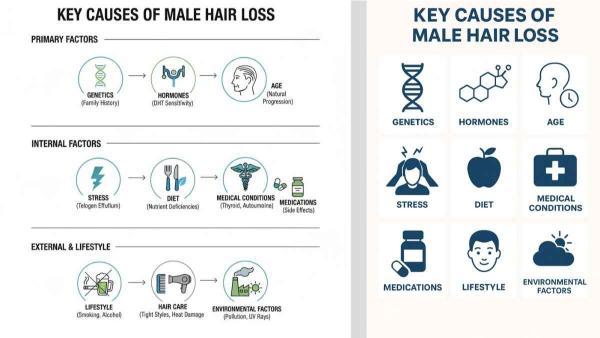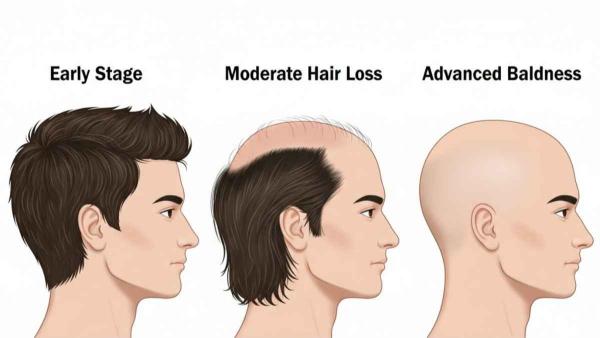Why Some Men Lose Hair and Others Keep a Full Head? Key Causes of Male Hair Loss and Remedies
Why Do Some Men Go Bald? Hair loss is a very common problem in men, but it affects everyone differently. By age 35, about two-thirds of American men experience hair loss, and by age 50, the rate increases to about 85%. Some men start experiencing hair loss in their twenties, while others remain fully bald until middle age.
Spain, Italy and France have the highest rates, while in the US about 43% of men are affected. About 35 million men in the United States suffer from this problem. The main cause of hair loss is genetics and hormones, but lifestyle and health also play a role. Understanding these causes can help men decide how to prevent, treat, or accept their hair loss with confidence.
Why Do Men Go Bald?

Men can go bald by a variety of factors, including genetics, hormones, age, mental or physical stress, unbalanced diet, medical problems, medications, lifestyle, hair care practices and environmental influences. All these factors can affect hair growth in different ways, resulting in thinning or hair loss.
Must Read: Walking Just 3,000 Steps a Day May Help Slow Alzheimer’s Disease Progression, Study Finds
Genetic Factors | The Main Reason
The primary reason some men go bald is genetics. Male pattern baldness, also known as androgenetic alopecia, is inherited from family genes. Men with a family history of baldness are more likely to experience hair loss. These genes make hair follicles sensitive to DHT (dihydrotestosterone), a hormone that causes the follicles to shrink and produce thinner hair until they stop producing hair altogether.
Hormones | DHT’s Role
DHT is a derivative of testosterone and plays a key role in hair loss. Men whose hair follicles are highly sensitive to DHT experience faster follicle miniaturization, leading to thinning hair and receding hairlines. Not all men have the same sensitivity, which is why some men maintain their hair despite high testosterone levels.
Age and Hair Growth Cycle
As men age, hair naturally becomes thinner. Hair grows in cycles, and over time, growth phases shorten while resting phases lengthen. This causes hair to become finer, weaker, and eventually fall out. Men who do not go bald typically have hair follicles that remain healthy and maintain longer growth cycles.
Lifestyle and Environmental Factors
Certain lifestyle choices can affect hair health:
Diet: Poor nutrition lacking protein, vitamins, or minerals can weaken hair.
Stress: High stress levels can trigger temporary hair loss (telogen effluvium).
Smoking & Alcohol: Both can reduce blood flow to hair follicles, impairing growth.
Hair Care Habits: Excessive use of harsh chemicals or heat can damage hair.
Men who maintain a healthy lifestyle and avoid damaging habits often retain more hair.
Medical Conditions and Medications
Some medical conditions, such as thyroid disorders, autoimmune diseases, or scalp infections, can accelerate hair loss. Certain medications, including chemotherapy drugs, blood thinners, and some antidepressants, also affect hair growth. Men without these conditions are less likely to experience baldness.
Why Some Men Keep Their Hair
Men who do not go bald often have:
- Less sensitivity to DHT in their hair follicles
- Stronger genetic protection against hair thinning
- Healthy lifestyles and good nutrition
- Minimal stress or medical issues affecting hair growth
It’s a combination of genetics, biology, and environment that determines who will go bald and who won’t.
Can Hair Loss Be Prevented?
While genetics can’t be changed, men can reduce hair loss risk by:
- Eating a balanced diet rich in vitamins and minerals
- Managing stress through meditation or exercise
- Avoiding harsh hair treatments
- Consulting a doctor for early treatments like minoxidil or finasteride
Conclusion
Hair loss in men is affected by genetics, hormones, age, lifestyle and health conditions. Some men have fuller hair because their hair follicles are less sensitive to the effects of DHT, their genetics are intact, and their lifestyle supports healthy hair. By understanding these factors, men can take proactive steps to maintain hair and manage hair loss effectively.
FAQs
What is male pattern baldness?
Male pattern baldness, or androgenic alopecia, is the most common type of hair loss in men. It usually begins with a receding hairline and thinning at the crown, eventually leading to baldness.
What are the common signs of hair loss in men?
Signs include gradual thinning on top of the head, receding hairline, patchy bald spots, sudden shedding, full-body hair loss, and scalp changes such as redness or scaling.
Can stress or lifestyle cause hair loss?
Yes. Emotional or physical stress, poor nutrition, smoking, excessive alcohol, and unhealthy hair care practices can accelerate hair loss or trigger temporary shedding.
What are the solutions for male hair loss?
Solutions include FUE hair transplants, wigs or hairpieces, hairstyle adjustments, styling products, medications like minoxidil and finasteride, and maintaining a healthy lifestyle.
Can hair loss be prevented?
While genetics cannot be changed, hair loss can be minimized by gentle hair care, avoiding harsh chemicals and heat, protecting hair from UV damage, quitting smoking, and monitoring medications that may contribute to hair thinning.







